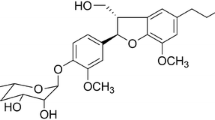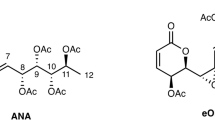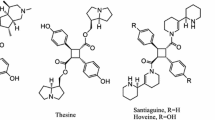Abstract
Compound 1, isolated from Dryopteris cycadina, was characterized as kempferol-3,4′-di-O-α-L-rhamnopyranoside on the basis of 1H and 13C NMR spectroscopic techniques. On the basis of preliminary screening data for this compound, its antinociceptive activity in different animal models was evaluated. Compound 1 displayed dose-dependent antinociceptive effects with maximum activity of 46.12 % at 10 mg/kg i.p. against acetic acid-induced writhing. In addition, it also showed dose-dependent blockade of noxious stimulation in both phases of formalin test with 40.78 and 43.44 % in the first and second phases at 10 mg/kg i.p., respectively. However, the injection of naloxone did not block the antinociceptive effect of compound 1 and thus ruled out the opioidergic involvement. It is, therefore, concluded with confidence that compound 1, isolated from D. cycadina, provoked strong antinociceptive activity and could be a lead analgesic drug candidate. Moreover, the mechanism of antinociceptive action by different flavonoids has also been investigated; results revealed that the bioactivity of compound 1 analogs should be discussed not only on the basis of flavonoids/biotarget interaction, but also on the basis of the catalytic activity of their bimetallic complexes.









Similar content being viewed by others
References
Adzu B, Amos S, Wambebe C, Gamaniel K (2001) Antinociceptive activity of Zizyphus spina-christi root bark extract. Fitoterapia 72(4):344–350
Ahmed S, Sultana M, Hasan MMU, Azhar I (2011) Analgesic and antiemetic activity of Cleome viscosa L. Pak J Bot 43:119–122
Arnaudinaud V, NGuyen L, Nay B, Peyrat JF, Chèze C, Vercauteren J (1998) Proceedings of ECSOC-2. The second international electronic conference on synthetic organic chemistry. http://www.mdpi.org/ecsoc-2.htm, CD-ROM edition ISBN 3-906980-01-4
Asoka L, Kakkar K, Chakre O (1992) Glossary of Indian medicinal plants. CSIR, New Delhi
Ben Hadda T, Fergoug T, Warad I, Masand V, Sheikh J (2013a) POM as a quick bioinformatic platform to select flavonoids and their metabolites as potential and efficient HIV-1 integrase inhibitors. Res Chem Intermed 39:1227–1244
Ben Hadda T, Kerbal A, Bennani B, Al Houari G, Daoudi M, Leite ACL, Masand VH, Jawarkar RD, Charrouf Z (2013b) Molecular drug design, synthesis and pharmacophore site identification of spiroheterocyclic compounds: Trypanosoma crusi inhibiting studies. Med Chem Res 22:57–69
Bennani B, Kerbal A, Daoudi M, Filali Baba B, Al Houari G, Jalbout AF, Mimouni M, Benazza M, Demailly G, Akkurt M, Yyldyrym SO, Ben Hadda T (2007) Combined drug design of potential Mycobacterium tuberculosis and HIV inhibitors: 3′,4′-di-substituted-4′H-spiro[isothiochromene-3,5′-isoxazol]-4(1H)-one. Arkivoc xvi:19-40
Byung-Sun M, Miyuki T, Chao-Mei M, Norio N, Masao H (2001) Kaempferol acetylrhamnosides from the rhizome of Dryopteris crassirhizoma and their inhibitory effects on three different activities of human immunodeficiency virus-1 reverse transcriptase. Chem Pharm Bull 49:546–550
Carroll AR, Quinn RJ, Pham NB, Pierens GK, Muresan S, Suraweera L, Palframan ME, Baron P, Neve JE (2006) Building a drug-like natural product library. In: Congress of drug design amongst the Vines, Hunter Valley, NSW, Australia 3–7 Dec
Chohan ZH, Youssoufi MH, Jarrahpour A, Ben Hadda T (2010) Identification of antibacterial and antifungal pharmacophore sites for potent bacteria and fungi inhibition: indolenyl sulfonamide derivatives. Eur J Med Chem 45:1189–1199
Ertl P, Rohde B, Selzer P (2000) Fast calculation of molecular polar surface area as a sum of fragment-based contributions and its application to the prediction of drug transport properties. J Med Chem 43:3714–3717
Gao Z, Ali Z, Zhao J, Qiao L, Lei H, Lu Y, Khan I (2008) Phytochemical investigation of the rhizomes of Dryopteris crassirhizoma. Phytochem Lett 1(4):188–190
Gasteiger J (1991) Chemical structure systems, computational techniques for representation, searching, and processing of structural information, edited by Ash JE, Warr WA, Willett P. Ellis Horwood, Chichester. ISBN 0-13-126699-3
Griffiths LA (1982) Mammalian metabolism of flavonoids. In: Harborne JH, Mabry TJ (eds) The flavonoids: advances in research. Springer-Science + Business Media, B. V, Berlin, pp 681–718
Hasnain F, Janbaz K, Qureshi M (2012) Analgesic effect of ketamine and morphine after tonsillectomy in children. Pak J Pharm Sci 25(3):599–606
Heller W, Forkmann G (1994) Biosynthesis of flavonoids. In: Harborne JB (ed) The flavonoids: advances in research since 1986. Chapman & Hall, London, pp 499–536
Ibrar M, Muhammad N, Barkatullah Khan H, Jahan F, Ashraf N (2012) Antinociceptive and anticonvulsant activities of essential oils of Zanthoxylum armatum. Phytopharmacol 3(1):191–198
Justesen U, Arrigoni E, Larsen BR, Amado R (2000) Degradation of flavonoid glycosides and aglycones during in vitro fermentation with human faecal flora. LWT Food Sci Technol 33:424–430
Khan H, Saeed M, Gilani AH, Khan MA, Dar A, Khan I (2010) The antinociceptive activity of Polygonatum verticillatum rhizomes in pain models. J Ethnopharmacol 127(2):521–527
Khan H, Saeed M, Khan MA, Khan I, Ashraf N (2011) Antinociceptive activity of aerial parts of Polygonatum verticillatum: attenuation of both peripheral and central pain mediators. Phytother Res 25(7):1024–1030
Kroll U, Reif K, Lederer I, Förster G, Zapp J (2009) Kaempferol-3,4′-di-O-beta-glucopyranoside-7-O-alpha-rhamnopyranoside as a new flavonoid from Iberis amara L. Pharmazie 64(2):142–144
Lipinski CA, Lombardo F, Dominy BW, Feeney PJ (1997) Experimental and computational approaches to estimate solubility and permeability in drug discovery and development settings. Adv Drug Deliv Rev 23:3–25
Marchand C, Johnson AA, Semenova E, Pommier Y (2006) Mechanisms and inhibition of HIV integration. Drug Discov Today Dis Mech 3(2):253–260
Mazid MA, Datta BK, Nahar L, Rashid MA, Bachar SC, Sarker SD (2010) Analgesic and diuretic properties of alpha-santalone from Polygonum flaccidum. Phytother Res 24(7):1084–1087
McNamara CR, Mandel-Brehm J, Bautista DM, Siemens J, Deranian KL, Zhao M, Hayward NJ, Chong JA, Julius D, Moran MM, Fanger CM (2007) TRPA1 mediates formalin-induced pain. Proc Natl Acad Sci USA 104:13525–13530
Mink JN, Singhurst JR, Holmes WC (2010) Dryopteris marginalis (Dryopteridaceae): new to Texas. Phytoneuron 53:1–6
Muhammad N, Saeed M, Khan H (2012) Antipyretic, analgesic and anti-inflammatory activity of Viola betonicifolia whole plant. BMC Complement Altern Med 12:59
Okokon J, Nwafor PA (2010) Antiinflammatory, analgesic and antipyretic activities of ethanolic root extract of Croton zambesicus. Pak J Pharm Sci 23(4):385–392
Schneider H, Schwiertz A, Collins MD, Blaut M (1999) Microbiol. Anaerobic transformation of quercetin-3-glucoside by bacteria from the human intestinal tract. Arch Microbiol 171:81–91
Shah NC, Singh SC (1990) Hitherto unreported phytotherapeutical uses from tribal pockets of Madhya Pradesh (India). Ethnobotany 2:91–95
Sheikh J, Juneja H, Ingle V, Ali P, Ben Hadda T (2011a) Synthesis and in vitro biology of Co(II), Ni(II), Cu(II) and Zinc(II) complexes of functionalized beta-diketone bearing energy buried potential antibacterial and antiviral O, O pharmacophore sites. J Saudi Chem Soc 17(3):269–276
Sheikh J, Parvez A, Juneja H, Ingle V, Chohan Z, Youssoufi MH, Ben Hadda T (2011b) Synthesis, biopharmaceutical characterization, antimicrobial and antioxidant activities of 1-(4′-O-β-D-glucopyranosyloxy-2′-hydroxyphenyl)-3-aryl-propane-1,3-diones. Eur J Med Chem 46(4):1390–1399
Singh IP, Bharate SB (2006) Phloroglucinol compounds of natural origin. Nat Prod Rep 23(4):558–591
Toker G, Küpeli E, Memisoğlu M, Yesilada E (2004) Flavonoids with antinociceptive and anti-inflammatory activities from the leaves of Tilia argentea (silver linden). J Ethnopharmacol 95(2–3):393–397
Uddin G, Rauf A, Rehman TU, Qaisar M (2011) Phytochemical Screening of Pistacia chinensis var. integerrima. Middle-East J Sci Res 7(5):707-711
Vasudeva SM (1999) Economic importance of pteridophytes. Indian Fern J 16:130–152
Verma P, Khan AA, Singh KK (1995) Traditional phytotherapy among the Baiga Tribe of Shadol District of Madhya Pradesh India. Ethnobotany 7:69–73
Winter J, Moore LH, Dowell VR, Bokkenheuser VD (1989) C-ring cleavage of flavonoids by human intestinal bacteria. Appl Env Micribiol 55(5):1203–1208
Zhao ZL, Leng CH, Wang ZT (2007) Identification of Daryopteris crassirhizoma and the adulterant species based on cpDNA rbcL and translated amino acid sequences. Planta Med 73:1230–1233
Acknowledgments
The authors are grateful for the financial support by the Higher Education Commission of Pakistan to complete this study. Professor T. Ben Hadda would like to thank ACTELION, the Biopharmaceutical Company of Swiss, for the molecular properties calculations.
Conflict of interest
The authors declared that we have no conflict of interest.
Author information
Authors and Affiliations
Corresponding authors
Rights and permissions
About this article
Cite this article
Ali, M., Khan, S.A., Rauf, A. et al. Characterization and antinociceptive activity (in vivo) of kempferol-3,4′-di-O-α-L-rhamnopyranoside isolated from Dryopteris cycadina . Med Chem Res 24, 3218–3229 (2015). https://doi.org/10.1007/s00044-015-1373-1
Received:
Accepted:
Published:
Issue Date:
DOI: https://doi.org/10.1007/s00044-015-1373-1




